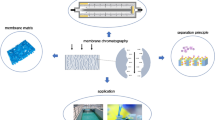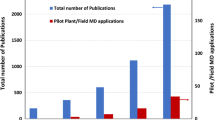Abstract
Although there is a voluminous literature on the determination of structural parameters (the pore radius, the ratio of membrane porosity to membrane thickness) of a nanofiltration (NF) membrane and its separation performance (such as the rejection and the permeation flux) by the simplified Teorell-Meyer-Sievers (TMS) model, little of this research comments on other theories and the consequences of linking modeling evaluation to technological application. Theories used to predict the separation performance of an NF membrane usually include: the non-equilibrium thermodynamic model, the pore model, the space charge model, the TMS model, the electrostatic and steric-hindrance model, and the semiempirical model. In the article, we briefly trace the origins or the general ideas of the above-mentioned theories. From there, recent researches on the characterization of membrane structural parameters and electrical properties (such as the surface charge density q w ) are reviewed. We then turn to research on the separation performance of an NF membrane for single-component solutions of inorganic electrolytes, neutral organic solutions, and a mixture solution of electrolytes or that of an electrolyte and neutral organic solute. Afterwards, we outline the applications of NF technology in the processes of product separation and conclude with a discussion on the role of models in such applications.
Similar content being viewed by others
References
Schafer A I, Fane A G, Waite T D. Nanofiltration: Principles and Applications. Oxfotd: Elsevier Ltd, 2005, 6–31, 263–304
Petersen R J. Composite reverse osmosis and nanofiltration membranes. J Membr Sci, 1993, 83: 81–150
Nakao S I. Determination of pore size and pore size distribution (3): Filtration membranes. J Membr Sci, 1994, 96: 131–165
Wang X L, Tsuru T, Nakao S I, Kimura S. Electrolyte transport through nanofiltration membranes by the space-charge model and the comparison with Teorell-Meyer-Sievers model. J Membr Sci, 1995, 103: 117–133
Fievet P, Labbez C, Szymczyk A, Vidonne A, Foissy A, Pagetti J. Electrolyte transport through amphoteric nanofiltration membranes. Chem Eng Sci, 2002, 57: 2921–2931
Wang X L, Zhang C H, Ouyang P K. The possibility of separating saccharides from a NaCl solution by using nanofiltration in diafiltration mode. J Membr Sci, 2002, 204: 271–281
Wang X L, Ying A L, Wang W N. Nanofiltration of L-phenylalanine and L-aspartic acid aqueous solutions. J Membr Sci, 2002, 196: 59–67
Li S L, Li C, Liu Y S, Wang S L, Cao Z A. Separation of L-glutamine from fermentation broth by nanofiltration. J Membr Sci, 2003, 222: 191–201
Wang D X, Wang X L, Tomi Y, Ando M, Shintani T. Modeling the separation performance of nanofiltration membranes for the mixed salts solution. J Membr Sci, 2006, 280: 734–743
Wang D X, Wu L, Liao Z D, Wang X L, Ando M, Shintani T. Modeling the separation performance of nanofiltration membranes for the mixed salts solution with Mg2+ and Ca2+. J Membr Sci, 2006, 284: 384–392
Jiraratananon R, Sungpet A, Luangsowan P. Performance evaluation of nanofiltration membranes of nanofiltration membranes for treatment of effuents containing reactive dye and salt. Desalination, 2000, 130: 177–183
Ducom G, Cabassud C. Interests and limitation of nanofiltration for the removal of voltaic organic compounds in drinking water production. Desalination, 1999, 124: 115–123
Schaep J, Vandecasteele C. Evaluating the charge of nanofiltration membranes. J Membr Sci, 2001, 188: 129–136
Wang X L, Tsuru T, Togoh M, Nakao S I, Kimura S. Evaluation of pore structure and electrical properties of nanofiltration membranes. J Chem Eng Japan, 1995, 28: 186–192
Vrijenhoek E M, Waypa J J. Arsenic removal from drinking water by a “loose” nanofiltration membrane. Desalination, 2000, 130: 265–277
Nakao S I, Kimura S. Models of membrane transport phenomena and their application for ultrafiltration data. J Chem Eng Japan, 1982, 15: 200–205
Spiegler K S, Kedem O. Thermodynamics of hyperfiltration (reverse osmosis): Criteria for efficient membranes. Desalination, 1966, 1: 311–326
Tsuru T, Nakao S I, Kimura S. Effective charge density and pore structure of charged ultrafiltration membranes. J Chem Eng Japan, 1990, 23: 604–610
Shang W J, Wang X L, Yu Y X. Transport phenomena of charged membranes based on the charge model. J Chem Ind Eng (China), 2006, 57(8): 1827–1834 (in Chinese)
Yaroshchuk A E. Osmosis and reverse osmosis in fine-porous charged diaphragms and membranes. Adv Colloid Interf Sci, 1995, 60: 1–93.
Morrison F A Jr, Osterle J F. Electrokinetic erergy conversion in ultrafine capillaries. J Chem Phys, 1965, 43(6): 2111–2114
Gross R J, Osterle J F. Membrane transport characteristics of ultrafine capillaries. J Chem Phys, 1968, 49(1): 228–233
Teorell T. Diffusion effect upon ionic distribution (I): Theoretical. P Natl Acad Sci USA, 1935, 21(15): 152–161
Sievers K H, Sievers J F. Théorie de la perméabilité ionique. Helv Chim Acta, 1936, 19: 629–664
Sievers K H, Sievers J F. Essais avec des membranes sélectives artificielles. Helv Chim Acta, 1936, 19: 665–677
Sievers K H, Sievers J F. Analyse de la structure de membrane végétales et animales. Helv Chim Acta, 1936, 19: 987–995
Burggraaf A J, Cot L. Fundamentals of Inorganic Membrane Science and Technology. Amsterdam: Elsevier Science, 1996, 599–601
Katchalsky A, Curran P R. Nonequilibrium Thermodynamics in Biophysics. Cambridge: Harvard University Press, 1965, 83–97
Onsager L. Reciprocal relations in irreversible processes (I). Phys Rev, 1931, 37(4): 405–426; (II). Phys Rev, 38(12): 2265–2289
Wang X L, Tsuru T, Togoh M, Nakao S I, Kimura S. Transport of organic electrolytes with electrostatic and steric-hindrance effects through nanofiltration membranes. J Chem Eng, 1995, 28(4): 372–380
Wang X L, Tsuru T, Nakao S I, Kimura S. The electrostatic and steric-hindrance model for the transport of charged solutes through nanofiltration membranes. J Membr Sci, 1997, 135: 19–32
Tsuru T, Nakao S I, Kimura S. Calculation of ion rejection by extended Nernst-Planck equation with charged reverse osmosis membranes for single and mixed electrolyte solutions. J Chem Eng Japan, 1991, 24(4): 511–517
Bowen W R, Mukhtar H. Characterization and prediction of separation performance of nanofiltration membranes. J Membr Sci, 1996, 112(2): 263–274
Bowen W R, Welfoot J S, Mukhtar H. Linearized transport model for nanofiltration: Development and assessment. AIChE J, 2002, 48: 760–773
Aleman J G, Dickson J M. Permeation of mixed-salt solutions with commercial and pore-filled nanofiltration membranes: membrane charge inversion phenomena. J Membr Sci, 2004, 239(2): 163–172
Bandini S, Vezzani D. Nanofiltration modeling: the role of dielectric exclusion in membrane characterization. Chem Eng Sci, 2003, 58(15): 3303–3326
Wang X L, Wang W N, Wang D X. Experimental investigation on separation performance of nanofiltration membranes for inorganic electrolyte solutions. Desalination, 2002, 145: 115–122
Wang D X, Su M, Yu Z Y, Wang X L, Ando M, Shitani T. Separation performance of a nanofiltration membrane influenced by species and concentration of ions. Desalination, 2005, 175: 219–225
Su M, Wang D X, Wang X L, Ando M, Shitani T. Rejection of ions by NF membranes for binary electrolyte solutions of NaCl, NaNO3, CaCl2, and Ca(NO3)2. Desalination, 2006, 191: 303–308
Miller M D, Bruening M L. Controlling the nanofiltration properties of multilayer polyelectrolyte membranes through variation of film composition. Langmuir, 2004, 20: 11545–11551
Goulas A K, Kapasakalidis P G, Sinclair H R, Rastall R A, Grandison A S. Purification of oligosaccharides by nanofiltration. J Membr Sci, 2002, 209: 321–335
Gyura J, Seres Z, Vatai G, Molnar E B. Separation of non-sucrose compounds from the syrup of sugar-beet processing by ultra-and nanofiltration using polymer membrane. Desalination, 2002, 148: 49–56
Vellenga E, Tragardh G. Nanofiltration of combined salt and sugar solutions: Coupling between retentions. Desalination, 1998, 120: 211–220
Tsuru T, Shutou T, Nakao S I, Kimura S. Peptide and amino acid separation with nanofiltration membranes. Sep Sci Technol, 1994, 29: 971–984
Martin-Orue C, Bouhallab S, Garem A. Nanofiltration of amino and peptide solution: Mechanisms of separation. J Membr Sci, 1998, 142: 225–233
Timmer J M K, Speelmans M P J, van der Horst H C. Separation of amino acids by nanofiltration and ultrafiltration membranes. Sep Purif Technol, 1998, 14:133–144
Grib H, Persin M, Gavach C, Piron D L, Sandeaux J, Mameri N. Amino acid retention with alumina γ nanofiltration membrane. J Membr Sci, 2000, 172: 9–17
Li S L, Li C, Liu Y S, Wang X L, Cao Z A. Separation of L-glutamine from fermentation broth by nanofiltration. J Membr Sci, 2003, 222: 191–201
Author information
Authors and Affiliations
Corresponding author
Rights and permissions
About this article
Cite this article
Shang, W., Wang, D. & Wang, X. Modeling of the separation performance of nanofiltration membranes and its role in the applications of nanofiltration technology in product separation processes. Front. Chem. Eng. China 1, 208–215 (2007). https://doi.org/10.1007/s11705-007-0038-0
Received:
Accepted:
Issue Date:
DOI: https://doi.org/10.1007/s11705-007-0038-0




